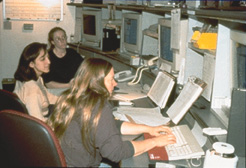| The ultraviolet is that part of the spectrum where we expect to witness events and see objects involving temperatures in the hundreds of thousands, even millions, of kelvins—hot regions like the seething atmospheres or eruptive flares of stars, and violent events, such as massive stars caught in the act of exploding, and active galaxies whose spinning hearts may harbor black holes. Yet ultraviolet astronomy has also contributed greatly to the study of the interstellar medium, by allowing a unique mapping of our local cosmic neighborhood. The line-of-sight technique for analyzing interstellar clouds, described in the text for optical observations, can also be applied to ultraviolet radiation. Astronomers search the ultraviolet spectra of distant, hot stars for narrow absorption lines caused by intervening interstellar clouds.
Short-wavelength ultraviolet radiation is effectively blocked by Earth's atmosphere. To study this region of the electromagnetic spectrum, instruments must be placed above our planet's atmospheric blanket.  (Sec. 5.6) One of the most successful satellites yet launched—placed in orbit in 1978 and finally shut down in late 1996—is the International Ultraviolet Explorer (IUE). More recently, the Extreme Ultraviolet Explorer (EUVE), launched in 1992 and also still operational, has closed one of the few remaining gaps in the electromagnetic spectrum not well explored by other means. The photograph below shows the Science Operations Center at the University of California at Berkeley, where undergraduate students work alongside scientists and engineers to command the spacecraft and acquire its data. (Sec. 5.6) One of the most successful satellites yet launched—placed in orbit in 1978 and finally shut down in late 1996—is the International Ultraviolet Explorer (IUE). More recently, the Extreme Ultraviolet Explorer (EUVE), launched in 1992 and also still operational, has closed one of the few remaining gaps in the electromagnetic spectrum not well explored by other means. The photograph below shows the Science Operations Center at the University of California at Berkeley, where undergraduate students work alongside scientists and engineers to command the spacecraft and acquire its data.
Only 25 years ago, astronomers had presumed that the gases filling the spaces among the stars would absorb virtually all short-wavelength UV radiation before it had a chance to reach Earth. But in 1975, during a historic linkup of the Apollo (U.S.) and Soyuz (USSR) space capsules, the onboard astronauts and cosmonauts performed a key experiment—they used a small telescope to detect extreme ultraviolet radiation from a few nearby, very hot stars. Shortly thereafter, theoretical ideas changed as astronomers began to realize that the interstellar gas is not all uniformly distributed in space. Rather, it is spread very unevenly, in cool dense clumps interspersed by regions of hot, low-density gas shaped like bubbles and tunnels.
|
Observations made by IUE of weak spectral lines from highly excited atoms showed that some regions of interstellar space are much thinner (5000 atoms/m3) and hotter (500,000 K) than previously expected. Part of the space among the dust clouds and the emission nebulae seems to contain extremely dilute yet seething plasma, probably the result of the concussion and expanding debris from stars that exploded long ago. Observations by EUVE and other space-based instruments have found that these superheated interstellar "bubbles," or intercloud medium, may extend far into interstellar space beyond our local neighborhood, and conceivably into the even vaster spaces among the galaxies.
The Sun seems to reside in one such low-density region—a huge cavity called the Local Bubble. Only because we live in this vast, low-density bubble can we detect so many stars in the extreme UV; the hot, tenuous interstellar gas is virtually transparent to this radiation.
The Local Bubble contains about 200,000 stars and extends for hundreds of trillions of kilometers, or nearly 100 pc. It was probably carved out by a supernova explosion that occurred in these parts roughly 100,000 years ago.  (Sec. 21.3) Our hominid ancestors must have seen it—a stellar catastrophe as bright as the full Moon. But since it is no longer there for us to see, modern astronomers have given this supernova remnant the name Geminga, from an expression in Latin dialect meaning "it's not there." Very recently, however, pulsating X-rays and gamma rays have been detected from a local pulsar—the dying core of a once-massive star that exploded nearby. (Sec. 21.3) Our hominid ancestors must have seen it—a stellar catastrophe as bright as the full Moon. But since it is no longer there for us to see, modern astronomers have given this supernova remnant the name Geminga, from an expression in Latin dialect meaning "it's not there." Very recently, however, pulsating X-rays and gamma rays have been detected from a local pulsar—the dying core of a once-massive star that exploded nearby.  (Sec. 22.2) Apparently, Geminga has at last been found. (Sec. 22.2) Apparently, Geminga has at last been found.

|